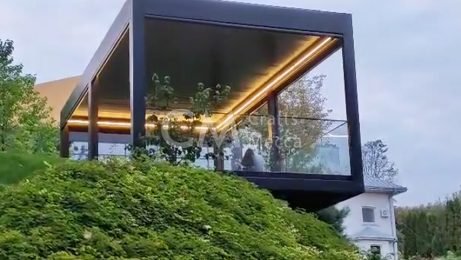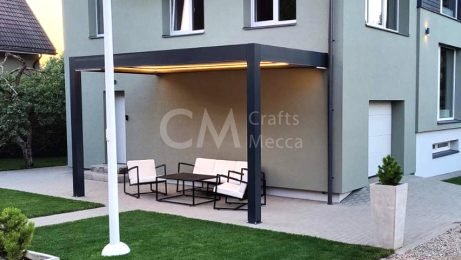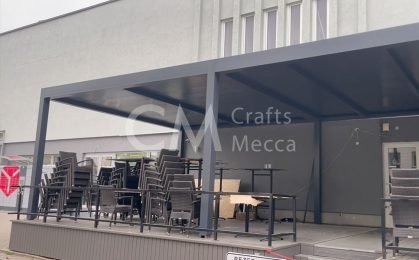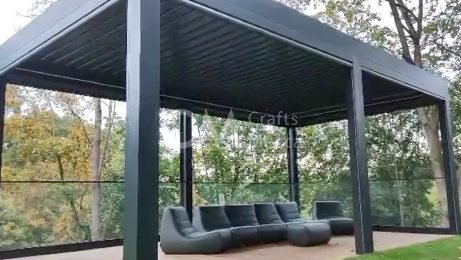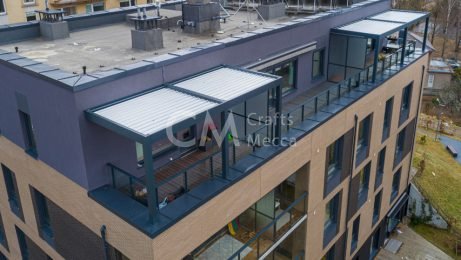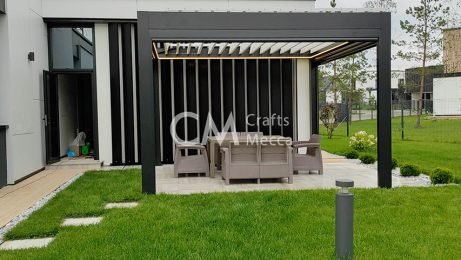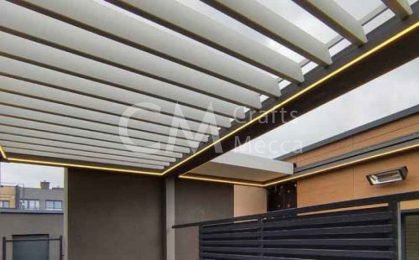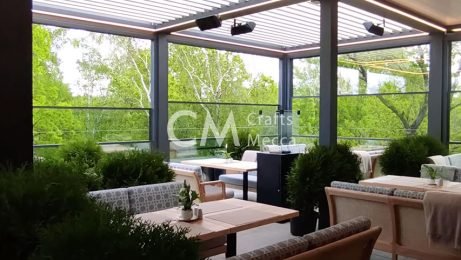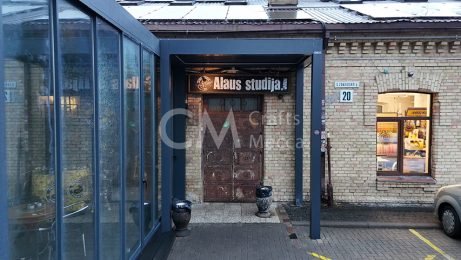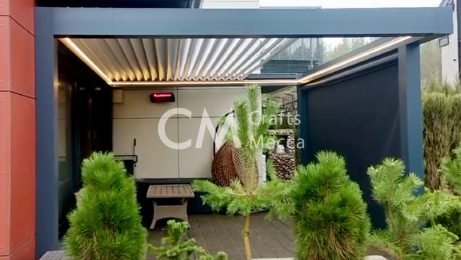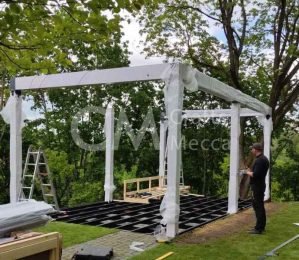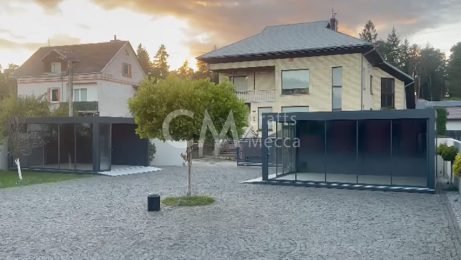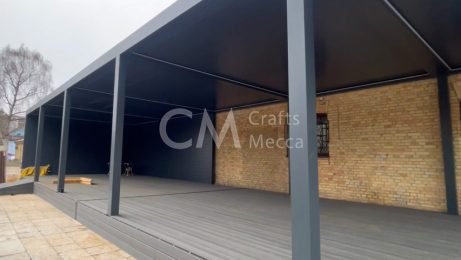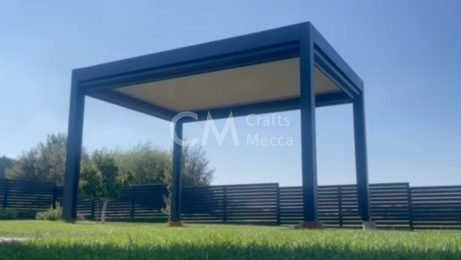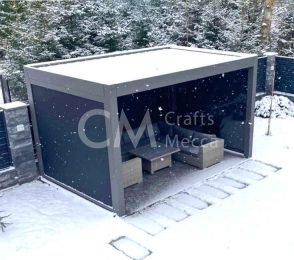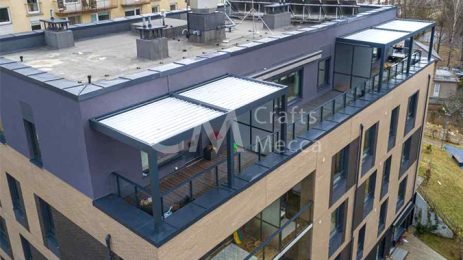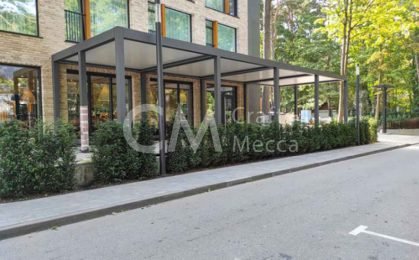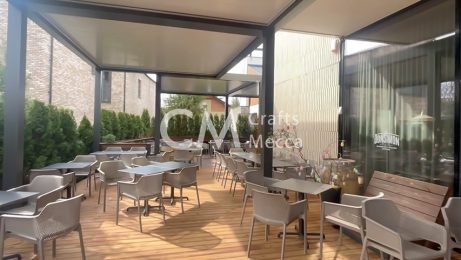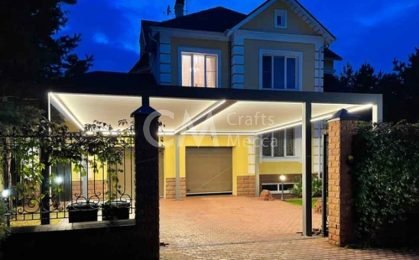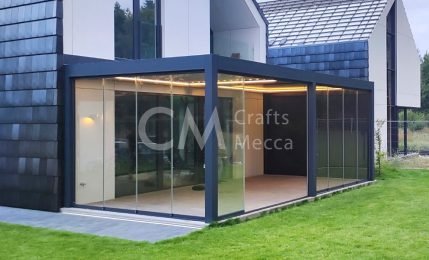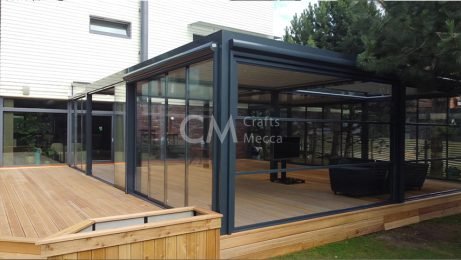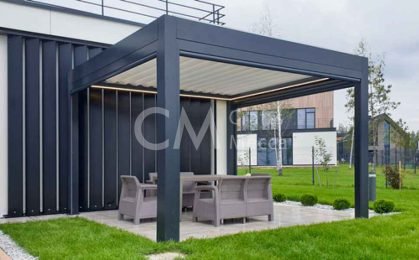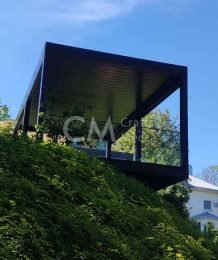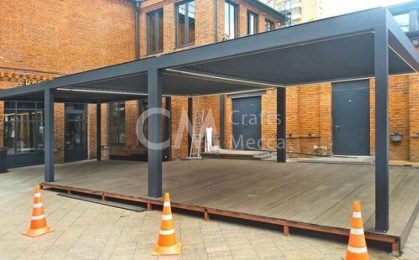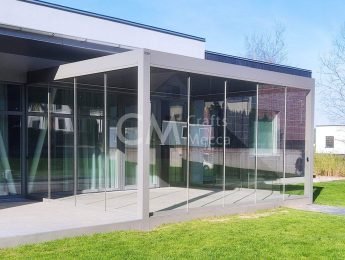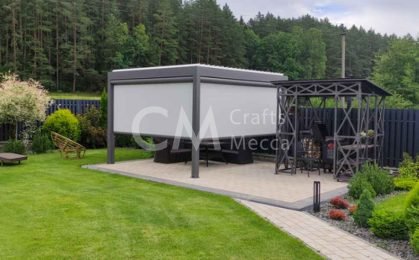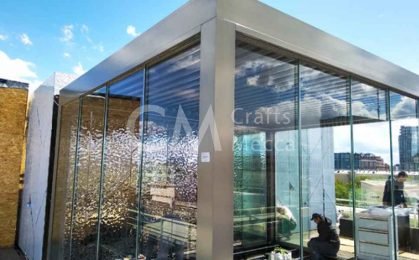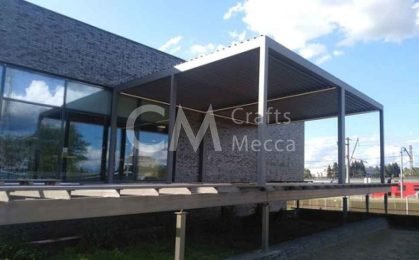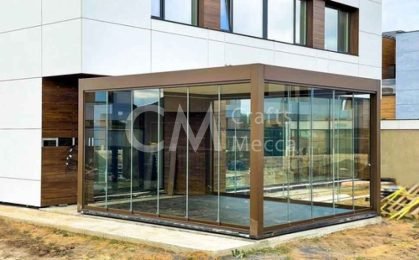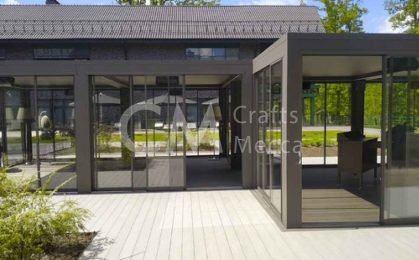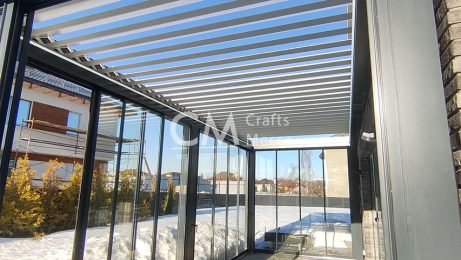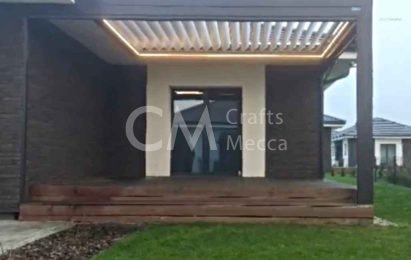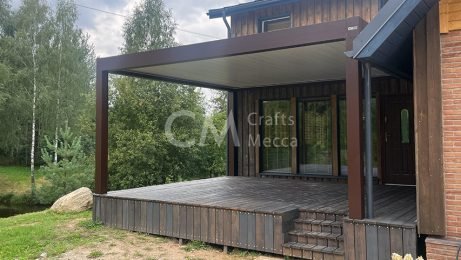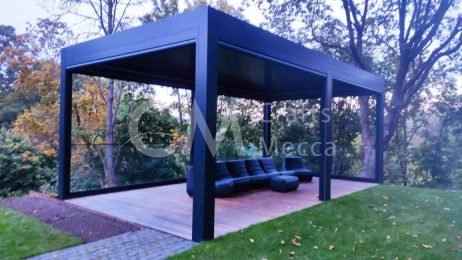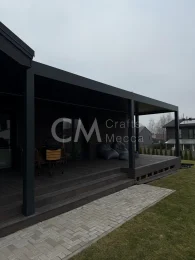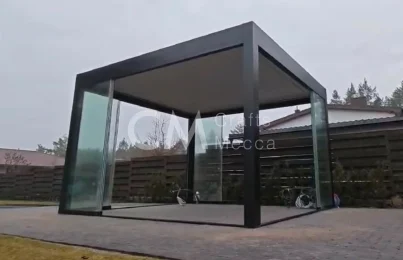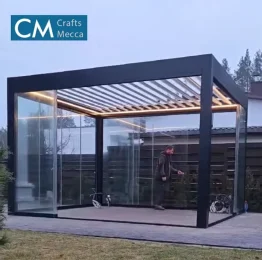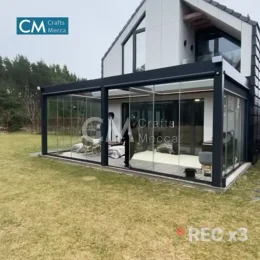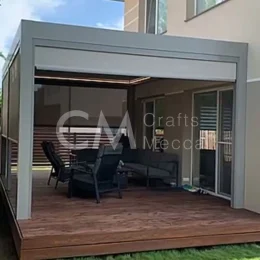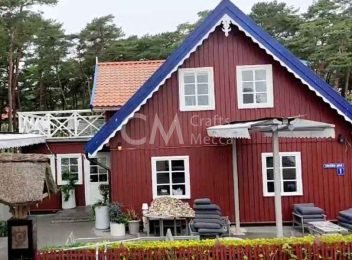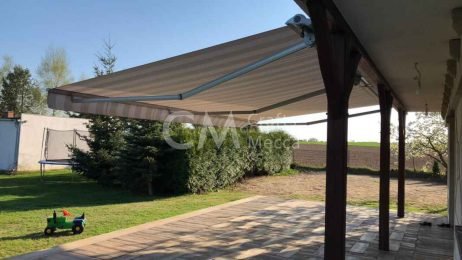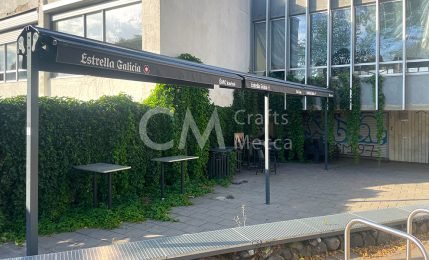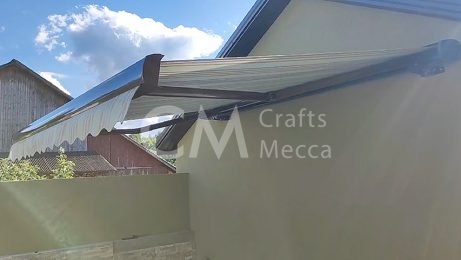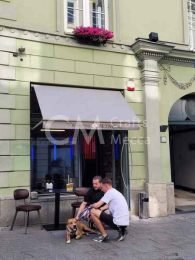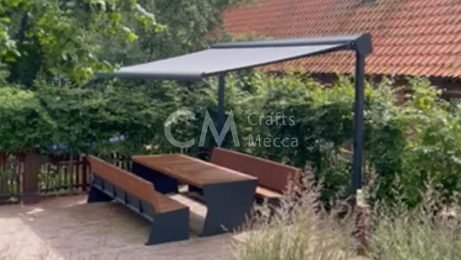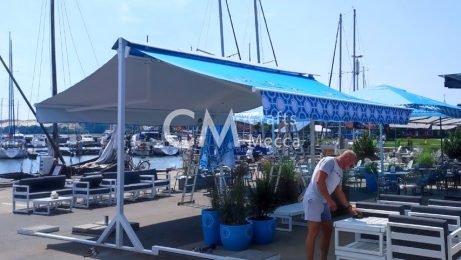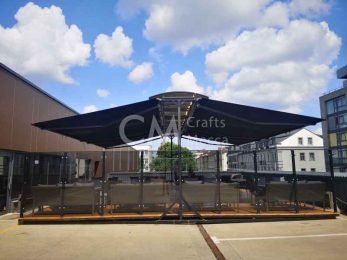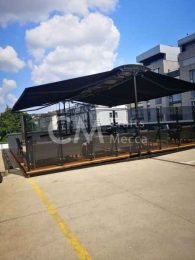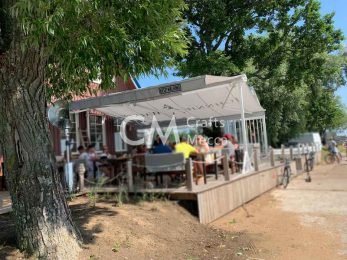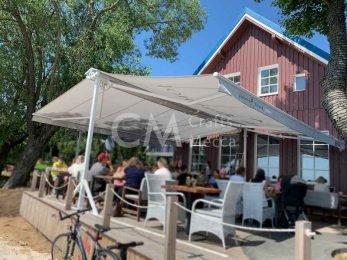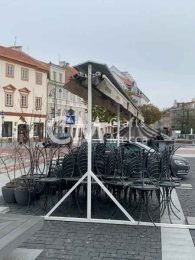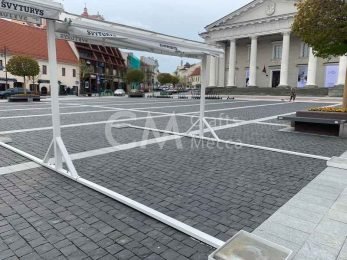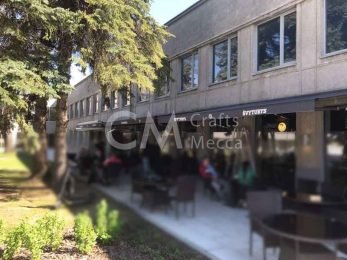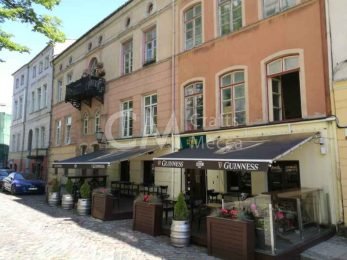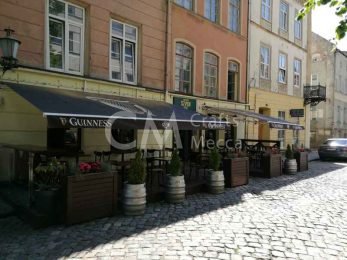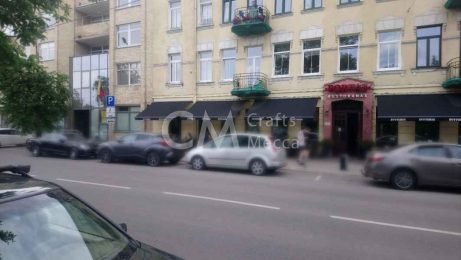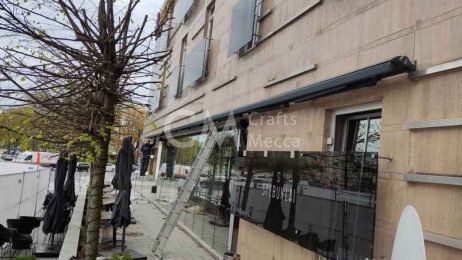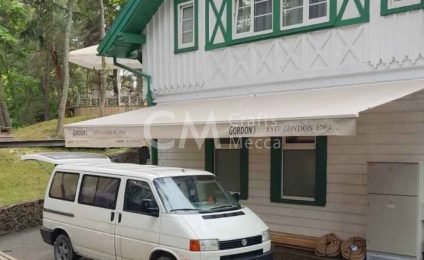1. Why it is important to know the difference between a pergola and an awning
Choosing choosing a gazebo for your home terrace, balcony or café, the question often arises as to what to choose: a pergola or an awning? Both structures provide shade, protection from the sun and rain, but they have different purposes and possibilities. To create a cosy, stylish and functional outdoor space, it is worth understanding the differences between the two structures and which one best suits your needs.
2. What is a pergola? Structure, purpose and main types
Pergola – An aluminium or steel pergola designed to create a comfortable outdoor seating area. Unlike conventional gazebos, pergolas are suitable for year-round use and feature a modern design and robustness.
The most common choices are bioclimatic pergolaswith a roof made up of pivoting or sliding blades. Swivel slats allow you to adjust the flow of light and air circulation, while sliding slats allow you to open the roof completely to enjoy the sun. Most bioclimatic pergolas come with automated slat control, a rainwater drainage system and optional integrated LED lighting, Zip screen outdoor blinds.
Awning pergolas – is a lighter option with a sliding PVC fabric roof. They are ideal for smaller spaces, terraces or commercial areas, such as the outdoor parts of restaurants. This type terrace pergolas add a touch of elegance and their design can be easily adapted to the architecture of the building.
According to the installation, pergolas can be:
- Freestanding – can be installed anywhere in the garden or yard.
- Wall-mounted – mounted on the wall of the house, with two supporting columns.
- Hanging – without columns, attached to the roof or facade of a building.
- Integrated – integrated into the building structure, creating a distinctive architectural solution.
In addition to pergolas, conservatories are also worth mentioning. Winter garden is a special glass pergola built as an extension to the house or as a separate structure. Conservatories are characterised by natural light, often overlooking a garden or park, and a sturdy frame that can withstand snow and wind loads. A conservatory pergola is often combined with conservatory awningwhich regulates the light penetration through the glass roof to provide extra comfort.
3. What is a marquise? Construction, materials and types
Marquise – is a compact, easy-to-install pergola structure, usually attached to the wall of a building. It is ideal for those who want to quickly create shade on a terrace, balcony or outdoor café area. Awnings provide not only shade but also comfort. They are pleasant to spend time under, they protect furniture and plants from the sun, and the variety of designs allows them to be adapted to both modern and classical buildings. In addition, awnings are easier and quicker to install than pergolas, and once the structure is folded up, you can enjoy the direct sun. Smart solutions can also be adapted to make life easier if needed, such as sun and rain sensors that automatically unfold and extend the awning.
Awnings are divided into several main types according to their application:
- Terrace awnings – designed to protect terraces or balconies from the sun.
- Balcony awnings – Awnings are fixed over balcony windows to protect rooms from overheating.
- Display awnings – Fixed awnings mounted over shop windows to protect the sun and decorate the building.
- Basketball awnings – Another type of balcony and window awning.
- Side roller blinds – Outdoor roller blinds that are installed on the sides to protect against the sun and wind.
- Winter garden – This type is installed on glass roofs or facades in conservatory pergolas. As the roof of the conservatory is transparent, the awning regulates the light entering the conservatory, so that a pleasant microclimate is maintained inside even on hot days.
Awnings are divided into several main types according to their design:
- Cassette awnings – The fabric and lever are completely concealed in the cassette, making it the most aesthetic and longest-lasting option.
- Semi-cassette awnings – partially covered fabric, a compromise between price and protection.
- Open awnings – the most cost-effective, suitable for locations where the structure is not directly exposed to the environment.
4. Pergola or awning? Let's compare their advantages and differences
The question when choosing the gazebo you want is, which one is better for you? Both types of gazebos have their strengths, so it is important to understand the key differences in order to choose.
Construction: Pergolas are more massive gazebos and have a strong aluminium frame to withstand snow, wind and rain. Awnings are lighter and more compact and are therefore more suitable for seasonal use.
Weather protection: The bioclimatic pergola allows you to control air circulation and light, has an integrated water drainage system, and the awning is most effective against sun and light rain.
Aesthetics and price: Pergolas give a sense of luxury and architectural integrity, but are more expensive. Awnings are a more cost-effective solution, ideal for smaller spaces.
By design awning pergolas Awnings are the closest – they have a sliding fabric roof, but are much more robust and protect not only from the sun, but also from wind or even heavy rain. For both awnings and pergolas, it is important choice of fabric – high quality, UV-resistant fabric for durability and aesthetics.
5. How to choose the ideal pergola solution for your outdoor space?
When choosing a pergola, it is important to consider not only the aesthetics of the pergola, but also the quality and functionality of the construction. The right type of gazebo will depend on how you plan to use the space: if you want a seasons-only seating area, choose a bioclimatic pergola with adjustable slats. If you want a quick to install, seasonal solution then awning pergola or awning will be a more practical choice.
Equally important – the roof material. For awnings and pergolas PVC, acrylic or polyester fabrics. The fabrics vary in transparency, UV, water and tensile strength. A high quality fabric should be watertight, UV filtered and easy to maintainotherwise it can fade, lose elasticity or even tear after a few years due to constant exposure to the environment.
Structural frame also has important implications for choice. Robust aluminium or steel structures, coated powder coatedfor durability and corrosion resistance. Cheap, thinner frames made of low-quality metal alloys and without a protective coating against environmental conditions often suffer from corrosion problems. These frames are prone to deformation, which makes pergolas short-lived and potentially dangerous due to their structural instability.
Aesthetics is also an important aspect when choosing a gazebo, and cannot be the last consideration. When choosing the colour, shade or pattern of the cabinet, it is worth matching them to the interior of the building facade or terrace. Neutral shades such as graphite grey, beige or whitecreate an elegant unity, while brighter colours (such as terracotta or blue) give a summery feel.
Additional factors to consider – water drainage system, wind resistance, automatic control and Certificatescertifying the safety of the structure. For example, CE marking or wind resistance class (according to EN 13561) indicates the wind strength for which the pergola is suitable.
A poor quality gazebo can lead to rapid wear and tear of the fabric, water leakage or even compromise the stability of the structure. That’s why it’s always a good idea to choose reliable manufacturers, quality materials and professional installation – this will ensure that your investment will last for many years and maintain its aesthetic appeal, whether it’s under the summer sun or the autumn rain.
Frequently asked questions
What is the difference between a pergola and an awning?
The main difference is that a pergola is a sturdy, stable structure that can be used all year round, whereas an awning is lighter and more seasonal. Pergolas have a metal frame, often with slats or a sliding roof. Awnings are usually fixed to the wall and can only be extended when needed.
What is a bioclimatic pergola?
A bioclimatic pergola is a modern structure with slats that swivel or slide to control the flow of light and air. It provides comfort in all seasons and is equipped with rain drainage and lighting systems. This pergola is ideal for both private courtyards and café terraces.
What is a marquise?
An awning is a shading system attached to the wall of a building, whose main function is to provide protection from the sun and light rain. It consists of an aluminium or steel structure and a special UV-resistant fabric. Awnings are a popular choice for both private homes and commercial spaces as they provide shade, comfort and an aesthetic sense of lightness.
How is a bioclimatic pergola better than an awning?
The bioclimatic pergola allows you to use the space all year round, as its construction can withstand rain, wind and snow. An awning is more suitable in the warm season when only shade from the sun is needed. In addition, a pergola looks more solid and integrates into the architecture of the building.
Does the awning protect against rain?
The awning protects against light rain, but is not designed for heavy downpours or wind. The fabric is moisture-resistant, but heavy loads can damage the structure. For this reason, awnings are best suited for sunny and dry days.
How much does a pergola cost?
The price of a pergola depends on the type, size and functionality. Bioclimatic pergolas are more expensive due to the automated system and slat design, while awning pergolas are more economical. On average, the price of a pergola ranges from several thousand to several thousand euros.
How much does an awning cost?
The price of an awning depends on the size, the quality of the fabric and the type of construction. Cassette awnings are more expensive because they protect the fabric better from the elements. Open or semi-cassette awnings are cheaper and suitable for smaller terraces.
Do pergolas need maintenance?
The pergola structure requires minimal maintenance - just check the joints once a season and clean the gutters. The slats or the awning can be easily cleaned with a mild detergent. If properly maintained, the pergola remains aesthetic and functional for many years.
Is an awning similar to an awning?
Yes, the awning pergola is structurally the closest to the awning, as both have a fabric roof. The difference is that the pergola has a solid aluminium frame and can be freestanding. The awning is mounted only on the wall of the building.
What to choose - a pergola or an awning?
If you want a year-round, sturdy and luxurious structure, choose a pergola. If practicality and seasonal shade are key, an awning is the perfect choice. With the right solution, you can achieve the perfect balance between aesthetics, functionality and price.
Conclusions
Pergolas and awnings differ in their construction, use and possibilities of use, so that the right pergola choice will depend on on your your budget and what comfort and durability the level you want to reach. For a sturdy, modern and all-season pergola – a bioclimatic pergola is the perfect choice. Meanwhile, if you are looking for a more cost-effective, compact and quick-to-install solution for the warm season – an awning is for you. By understanding the fundamental differences between awnings, and being able to properly assess the quality of the construction to suit your needs, you will be able to create an outdoor spacethat will not only provide protection from the weather, but also become your favourite home relaxation space.
📞 Want to know which solution is right for your yard? Contact our team – we’ll help you realise your vision for your yard!


